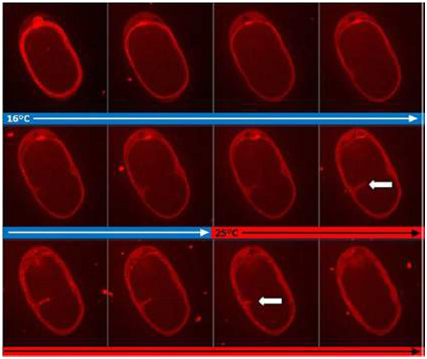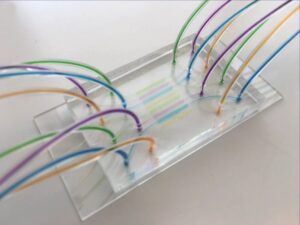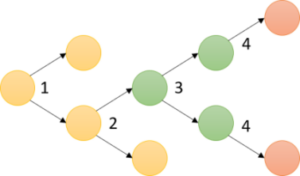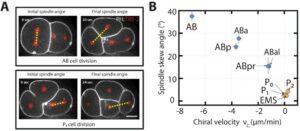C.elegans thermosensitive mutants
During C. elegans embryo division, the CYK-4 protein is required for the completion of cytokinesis (but not to form a furrow or initiate ingression). At the “permissive” 16°C temperature, the CYK-4 protein is functional but over 25°C it becomes inactivated. Such a mutant is called “thermosensitive”.

Ultra fast temperature shift device for in vitro experiments under microscopy
CherryTemp-induced cell division phenotype
During our experimentation, C. elegans thermosensitive embryo mutants (CYK-4 ts) were examined under the microscope with a CherryTemp platform. This system allowed to selectively modify the temperature of embryo samples between 16°C and 25°C resulting in cytokinesis blocking. Fig 1 shows unprecedently observed phenomenon during cell division.
CherryTemp offers unique properties to get the best tuning of C. elegans samples temperature and obtain results that could not be observed otherwise!
FAQ
A thermosensitive mutant, also called ts, is one where a protein’s activity is dependent on the temperature. The protein is functional at what is known as a "permissive" temperature. It becomes inactivated when the temperature is changed to a "restrictive" level. An example is the CYK-4 ts mutant in C. elegans. This specific protein is functional at 16°C. If the temperature is raised to over 25°C, the CYK-4 protein is inactivated. This characteristic allows researchers to control the protein’s activity by changing the sample’s temperature. Such mutants are used in experiments to study the specific function of proteins during various cellular processes, such as division.
The CYK-4 protein has a specific role during the division of C. elegans embryos. It has been identified as being required for the completion of cytokinesis. Cytokinesis is the process where the cell’s cytoplasm divides, leading to two separate daughter cells. It is important to note what the protein is not required for. The CYK-4 protein is not needed for the initial steps of this process. These steps include the formation of the cleavage furrow. It is also not required to initiate the ingression of the furrow. Its function is specifically related to the final completion of the cytokinesis stage.
When CYK-4 thermosensitive mutant embryos are shifted from the permissive temperature to the restrictive one, a specific effect is observed. Experiments have been done by changing the temperature of the embryo samples from 16°C to 25°C. This shift to the higher, restrictive temperature causes the CYK-4 protein to become inactivated. For embryos that are in the process of dividing, this inactivation results in cytokinesis arrest. The process of cell division is blocked. Observations from such experiments have shown the cleavage furrow, which forms and pulls inwards at 16°C, actually regresses when the temperature is shifted to 25°C. This demonstrates that the protein’s function is stopped, preventing the completion of division.
The CYK-4 thermosensitive (ts) mutant embryos were studied by using a specific experimental setup. The embryos were examined under a microscope. A temperature control platform was used with the microscope. This system permitted the temperature of the embryo samples to be selectively modified. For these experiments, the temperature was changed between the permissive level of 16°C and the restrictive level of 25°C. This precise temperature change allowed for the inactivation of the CYK-4 protein at a specific time. The observed result of this temperature shift was the blocking of cytokinesis. This method of controlling temperature allows researchers to study the effects of inactivating a protein during a dynamic cellular process.



